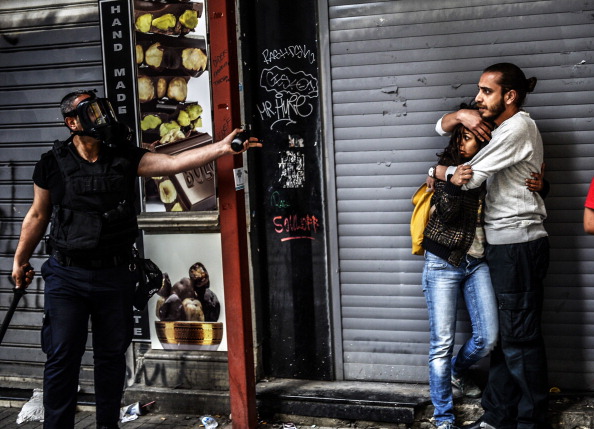
A man protects a woman as they face a police officer dispersing protesters who gathered near Taksim square in Istanbul as the police blocked access to the square during the one year anniversary of the Gezi park and Taksim square demonstrations
On the first anniversary of the Gezi Protests and their brutal suppression in Turkey, central Istanbul resembled nothing so much as a city under occupation. Public transportation into the city center was cancelled. Ferry service from the Asian to the European side of the metropolis was ended by the late afternoon. You could leave, but you couldn’t come back.
This is the image of the new Turkey, where dissent is stifled with overwhelming force and massive police presence.
There seems to have also been sporadic efforts to limit foreign press access.
CNN’s Ivan Watson was briefly detained – and apparently kicked – during a live feed. Isobel Finkel of Bloomberg reports in a tweet that she and another journalist were repeatedly asked at checkpoints whether they were foreign or local press. When they said foreign, they were turned away.
A few days later Prime Minister Tayyip Erdogan specifically targeted the foreign press as enemy “agents”:
CNN International made an eight-hour broadcast during last year’s Gezi events. Why? To stir trouble in my country. This year, they have been caught red-handed…Those don’t have anything to do with independent and impartial media. They have been given tasks. They are agents.
Phalanxes of heavily armed police blocked every artery into Taksim Square and lined all the major streets in Taksim and Besiktas. On the side streets, reserves were waiting. They were there to ensure that no repeat of last year’s protest would be possible and to demonstrate the state’s overwhelming capacity to stifle dissent.
Turkish media reported that as many as 25,000 police and fifty water cannon trucks had been mobilized to control the Taksim area. This use of massive police power, already employed during the suppression of the May 1 demonstrations, uses overwhelming numbers to preclude any possibility of demonstrations.
I was meeting Andrew Gardner, Amnesty International’s researcher on Turkey, to observe events and witness any human rights violations.
The stifling police presence and barricades were, in and of themselves, a violation of the government’s responsibility to allow for freedom of assembly and expression. Perhaps even more troubling was the presence of large numbers of individuals without uniforms or other identification who were carrying identical backpacks and truncheons. Police in civilian clothing, they wandered the side streets in groups of three or four and, as Gardner explained, were a signal that the evening could quickly turn violent: “the lack of identification is, in itself a breach of Turkish law; it meant that they could engage in violence without any serious risk of identification.”
We discussed options and decided that he would stay in the area around Taksim, where the major demonstration was planned, while I would go to Besiktas, which had been the scene of significant violence last year.
For the hours that I observed, Besiktas was relatively quiet. A small group of perhaps 150 protesters gathered around Kartal Square, but eventually dispersed in the face of police forces that were at least ten times their number. Turkish news reports indicate that groups attempting to make their way to Taksim later in the evening were stopped, with some arrests. Late in the evening, I heard the sound of pots and pans being banged from windows, a popular means for voicing dissent during last year’s protests.
By early evening, however, Gardner saw events in Taksim coming to a head: Taksim Solidarity, a major coalition of civil society organizations, organized demonstrators in a sit down protest, calling on police to remove the barricades..
BY HOWARD EISSENSTAT
BY HOWARD EISSENSTAT

No comments:
Post a Comment